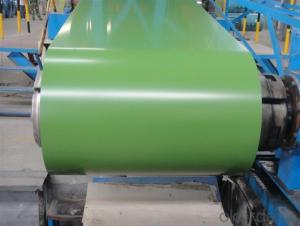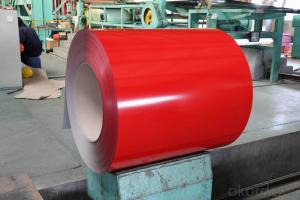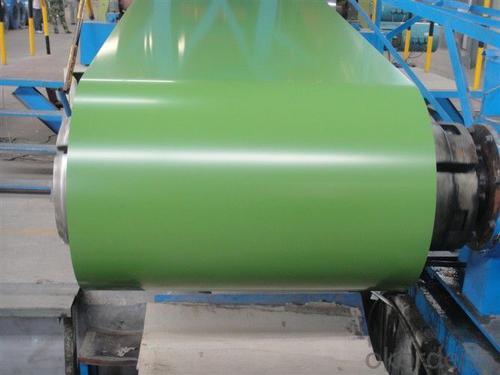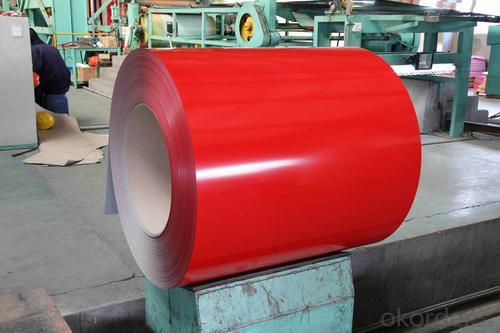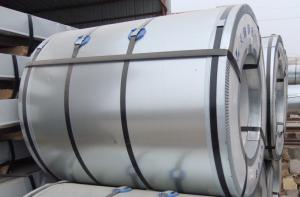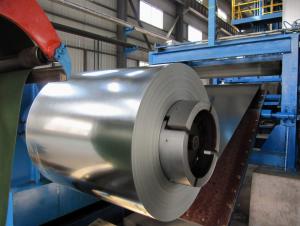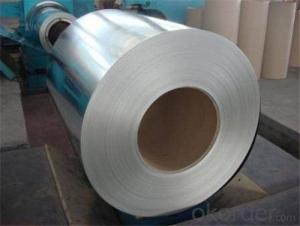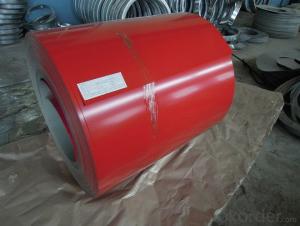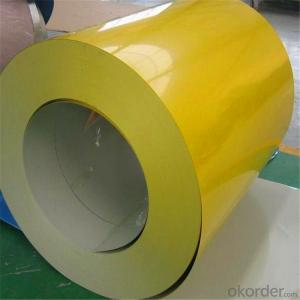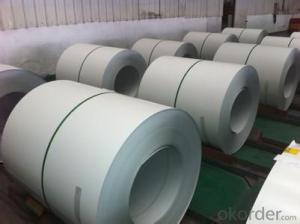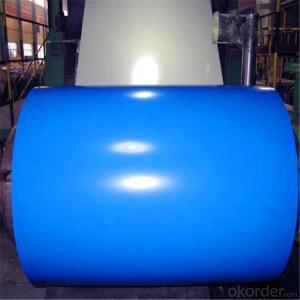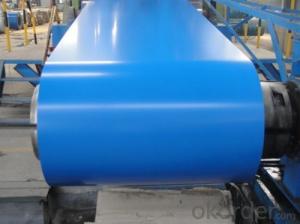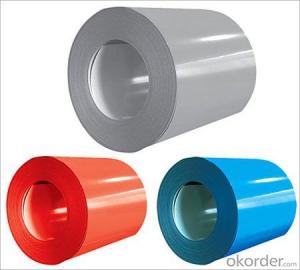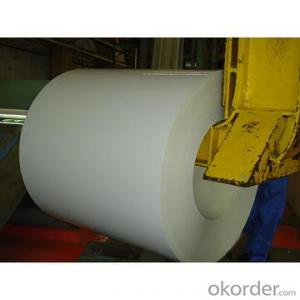Prime Quality Prepainted Galvanized Steel Coil
- Loading Port:
- China Main Port
- Payment Terms:
- TT OR LC
- Min Order Qty:
- -
- Supply Capability:
- -
OKorder Service Pledge
OKorder Financial Service
You Might Also Like
1) AVAILABLEDESIGNATION OF (Prepainted galvanized steel coils) printed PPGI coils
Quality Q/BQB440-2003 JIS G3312-1994 EN 10326-2004 ASTM A653-02a
EN 10327-2004(BASE PLATE)
(BASEPLATE)
Commercial SteelTDC51D CGCC DX51D+Z/AZ CS Type A/B/C
Forming Steel(TSt01,TSt02,TSt03) CGCD1 FS Type A, Type B
Drawing TDC52D/TDC53D - DX52D+Z/AZ DDS TYPE A/C
Steel DX53D+Z/AZ
StructuralTS280GD(TStE28) CGC400 S280D+Z/AZ SS275
SteelTS350GD(TStE34) CGC440 S350D+Z/AZ SS340 Class1
2) OURSPECIFICATION OF (Prepainted galvanized steel coils) printed PPGI coils
Available Size:
ManufacturerThickness Width Length of plate Inner diameter of coil
JIANGSU HUIYESTEEL SHEET CO.,LTD 0.2-1.2mm 800/914/1000/1200/1219/1250mm 1000-6000mm508mm/610mm
Coated Mass OF(Prepainted galvanized steel coils) printed PPGI coils:
Base plateAvailable Coated Mass(g/m^2)
Galvanized Steel80, 100, 120, 160, 180
Galvalume Steel50, 70, 150
AvailablePainting OF (Prepainted galvanized steel coils) printed PPGI coils:
Category ofPainting Item Code
Polyester PE
High-durabilitypolyester HDP
Silicon modifiedpolyesters SMP
Polyvinylidenefluoride PVDF
Easy-Cleaning —
PaintingThickness Top side: 20+5microns;
Bottom side:5~7microns.
Color SystemProduce according to RAL Color System or as per buyer’s color sample.
Paintingstructure Top surface Bottom surface
Primer coatingNo coating 1/0
Primer coatingPrimer coating 1/1
Primer coating +Finish coating No coating 2/0
Primer coating +Finish coating Primer coating or single back coating 2/1
Primer coating + Finish coating Primer coating + Finish back coating 2/2- Q: i mean cor ten steel( rusted)
- Bill summed it up pretty quick and provided a link. For some reason you are focusing on the copper content when it really is insignificant in the overall picture of the sun hitting its surface. If you could elaborate more, maybe we could offer a better answer.
- Q: I know this is an alloy, but can it be mixed to form a superior steel? Therefore less likely to stain?
- yes loads
- Q: What are the different coil slitting line configurations used for steel coils?
- There are several different coil slitting line configurations used for steel coils, including the looping pit slitting line, the looping tower slitting line, the non-looping slitting line, and the traveling head slitting line. Each configuration offers unique advantages and is suited for specific applications and production requirements.
- Q: What is the weight range of steel coils?
- The weight range of steel coils can vary greatly depending on the specific type and dimensions of the coil. However, typically, steel coils can weigh anywhere from a few hundred kilograms to several tonnes.
- Q: What are the different grades of steel used in coil manufacturing?
- There are various grades of steel used in coil manufacturing, including low carbon steel, medium carbon steel, high carbon steel, stainless steel, and alloy steel. These grades differ in their composition, strength, and corrosion resistance, allowing manufacturers to choose the most suitable grade for specific applications and requirements.
- Q: How are steel coils used in the production of steel containers?
- Steel containers rely heavily on steel coils as a vital component in their production. These coils, made from flat-rolled steel, serve as the foundation for the container's main body. To start the process, the steel coils are unwound and fed into a rolling mill. Here, they undergo a sequence of procedures to shape and mold the steel. One of these steps involves heating the coils to a specific temperature, making them more malleable and easier to manipulate. Subsequently, the hot coils pass through a series of rollers that gradually reduce their thickness and elongate them to the desired size. This entire procedure is referred to as hot rolling. Once the steel coils have been rolled to the necessary thickness, they are then cooled and transformed into sheets. These sheets are further treated to eliminate any imperfections or irregularities, guaranteeing a smooth and even surface. This is accomplished through processes like pickling, where acid is used to remove any scale or rust, and cold rolling, where the sheets are passed through rollers at room temperature to achieve the desired thickness and surface finish. After the sheets have been cleaned and refined, they are molded into the shape of the container. This typically involves a technique known as stamping, in which hydraulic presses are used to press the steel sheets into a mold. The mold determines the container's shape and size, and the steel sheets are pressed against it with great force, resulting in the desired container shape. Once the containers have been formed, they undergo several finishing processes, including welding, painting, and coating. These processes are carried out to enhance the containers' durability, appearance, and resistance to corrosion. These final touches ensure that the steel containers meet the necessary standards and are of high quality for their intended use. In conclusion, steel coils are of paramount importance in the manufacturing of steel containers, as they provide the raw material needed for their production. Through a series of steps, the steel coils are shaped, cut, and formed into sheets, which are then further processed and molded into the desired container shape. The outcome is a robust and dependable steel container suitable for various applications across industries.
- Q: How are steel coils used in the production of construction equipment?
- Steel coils are used in the production of construction equipment as they are a crucial raw material for manufacturing various components such as frames, beams, plates, and structural parts. These coils are processed through cutting, bending, and welding techniques to form the required shapes and structures used in the construction industry.
- Q: This EN10025 S355JR is a European code for steel, of which the properties can be found here.
- *EN 10 025 S355JR/JO is comes under structural steel catagories. Equivalent standard is-ASTM A 572 Gr 50. -Above areHigher strength micro-alloyed steel. -The above-mentioned structural steel grades may be welded using any of the standard metal arc and resistance welding processes, usually without any special precautions.
- Q: What are the common coil inspection techniques?
- Some common coil inspection techniques include visual inspection, magnetic particle inspection, eddy current testing, and ultrasonic testing.
- Q: Can steel coils be coated with abrasion-resistant materials?
- Yes, steel coils can be coated with abrasion-resistant materials. These materials are applied to the surface of the steel coils to enhance their resistance to wear and tear caused by friction, impact, or scratching. The abrasion-resistant coating provides a protective layer that helps prolong the lifespan and durability of the steel coils.
Send your message to us
Prime Quality Prepainted Galvanized Steel Coil
- Loading Port:
- China Main Port
- Payment Terms:
- TT OR LC
- Min Order Qty:
- -
- Supply Capability:
- -
OKorder Service Pledge
OKorder Financial Service
Similar products
Hot products
Hot Searches
Related keywords
